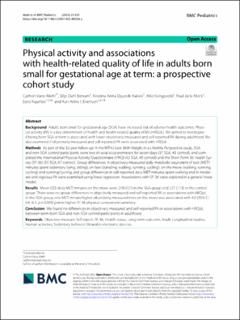| dc.contributor.author | Mehl, Cathrin Vano | |
| dc.contributor.author | Benum, Silje Dahl | |
| dc.contributor.author | Aakvik, Kristina Anna Djupvik | |
| dc.contributor.author | Kongsvold, Atle Austnes | |
| dc.contributor.author | Mork, Paul Jarle | |
| dc.contributor.author | Kajantie, Eero Olavi | |
| dc.contributor.author | Evensen, Kari Anne Indredavik | |
| dc.date.accessioned | 2024-01-17T09:29:48Z | |
| dc.date.available | 2024-01-17T09:29:48Z | |
| dc.date.created | 2023-09-08T14:46:40Z | |
| dc.date.issued | 2023 | |
| dc.identifier.citation | BMC Pediatrics. 2023, 23 (1), . | en_US |
| dc.identifier.issn | 1471-2431 | |
| dc.identifier.uri | https://hdl.handle.net/11250/3112059 | |
| dc.description.abstract | Background Adults born small for gestational age (SGA) have increased risk of adverse health outcomes. Physi- cal activity (PA) is a key determinant of health and health-related quality of life (HRQoL). We aimed to investigate
if being born SGA at term is associated with lower objectively measured and self-reported PA during adulthood. We also examined if objectively measured and self-reported PA were associated with HRQoL.
Methods As part of the 32-year follow-up in the NTNU Low Birth Weight in a Lifetime Perspective study, SGA
and non-SGA control participants wore two tri-axial accelerometers for seven days (37 SGA, 43 control), and com- pleted the International Physical Activity Questionnaire (IPAQ) (42 SGA, 49 control) and the Short Form 36 Health Sur- vey (SF-36) (55 SGA, 67 control). Group differences in objectively measured daily metabolic equivalent of task (MET) minutes spent sedentary (lying, sitting), on feet (standing, walking, running, cycling), on the move (walking, running, cycling) and running/cycling, and group differences in self-reported daily MET minutes spent walking and in moder- ate and vigorous PA were examined using linear regression. Associations with SF-36 were explored in a general linear model.
Results Mean (SD) daily MET minutes on the move were 218 (127) in the SGA group and 227 (113) in the control group. There were no group differences in objectively measured and self-reported PA or associations with HRQoL. In the SGA group, one MET minute higher objectively measured time on the move was associated with 4.0 (95% CI: 0.6–6.5, p = 0.009) points higher SF-36 physical component summary.
Conclusion We found no differences in objectively measured and self-reported PA or associations with HRQoL between term-born SGA and non-SGA control participants in adulthood. | en_US |
| dc.language.iso | eng | en_US |
| dc.rights | Navngivelse 4.0 Internasjonal | * |
| dc.rights.uri | http://creativecommons.org/licenses/by/4.0/deed.no | * |
| dc.title | Physical activity and associations with health-related quality of life in adults born small for gestational age at term: a prospective cohort study | en_US |
| dc.type | Peer reviewed | en_US |
| dc.type | Journal article | en_US |
| dc.description.version | publishedVersion | en_US |
| cristin.ispublished | true | |
| cristin.fulltext | original | |
| cristin.qualitycode | 1 | |
| dc.identifier.doi | 10.1186/s12887-023-04256-y | |
| dc.identifier.cristin | 2173585 | |
| dc.source.journal | BMC Pediatrics | en_US |
| dc.source.volume | 23 | en_US |
| dc.source.issue | 1 | en_US |
| dc.source.pagenumber | 0 | en_US |

